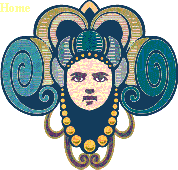|
As seen from the top, the skull has a certain expected size and shape. It is the contents that got out of hand. Our species - as with those others that
share our basic structural blue print begins life with the first game of hoops...
getting this ball
through this hoop.
Being smart required more brain and with that a larger size skull. Having the skull not be a single solid bone, but rather floating
plates allowed some degree of accommodation to the issue of shape (with the head passing sideways - usually the back of the baby skull is toward the mother's left hip as the baby faces her right side).
But that was not enough. To allow for a bigger brain than the hoop could pass, we got : CHILDHOOD. The brain - a work in progress.
Tain't done at birth. Tisent. So when that teenager is looking you right in the face and saying "So, what's the problem?" You
see? It still ain't done! Wisdom is the last hunk added. You can't add that part until the pain centers are all optimized.
But that floating bones thing. It is part of the early solution. It is also, sometimes, a problem. As you see here, the bone portions
are all knitted - welded sort of - to each other. At first, for brain growth, those are unjoined, with a wee bit of space between. What happens if one seam links up too soon?
The brain still has to grow. So will the volume bulge out somewhere else? Yes. What if - and this sounds weird - what if
pressure were applied from the outside to make expansion in one direction tougher? The obvious. It goes the easy way. Does that happen?
In utero, sure. A placenta positioned just so... Or a child whose movements are poor and with the head kept in a single posture
always on the bed one way only... or some strap applied to a breathing device for long periods pressing on the skull...
Whatever. Most typically, it is when a portion of the seam just links up for no good reason.
If the sagittal suture (the crack going this way <==>) welds (closes) too early then front to back expansion is stopped and
the head becomes flat front to back (brachycephalic).
If the coronal suture ( goes | this way ) closes, then side to
side expansion is difficult and the head grows front to back and looks narrow side to side (scaphycephaly).
But if there is spotty varied closure of sutures or asymmetric odd forces applied from outside or disturbed rates of growth
within, then the skull becomes oddly shaped or most commonly trapezoidal or skewed (plagiocephaly).
That external forces could deform the skull made potential correction of an already deformed skull seem attainable by
applying shaped external forms on the growing child. They have to expand but, yet, nudge. They also, by their roundness, stop the head from resting on its flat spot and so encourage varied
posture. Altered child positioning and such external devices can help.
Obviously, you can't wait until everything gets solid. Nor do you attack every child born with odd head shape as most
resolve once the uterine pressure is removed.
What has this to do with pediatric orthopedics? Nothing. But, many of our children with difficulties share these problems. It
seems fitting to at least mention it. Here is a more informative link:

Want see more detailed skull anatomy?
Then click this=>
|
